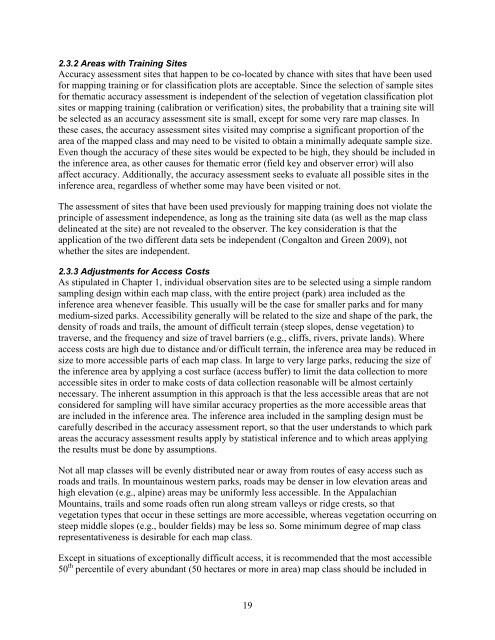Thematic Accuracy Assessment Procedures. Version 2 - USGS
Thematic Accuracy Assessment Procedures. Version 2 - USGS
Thematic Accuracy Assessment Procedures. Version 2 - USGS
Create successful ePaper yourself
Turn your PDF publications into a flip-book with our unique Google optimized e-Paper software.
2.3.2 Areas with Training Sites<br />
<strong>Accuracy</strong> assessment sites that happen to be co-located by chance with sites that have been used<br />
for mapping training or for classification plots are acceptable. Since the selection of sample sites<br />
for thematic accuracy assessment is independent of the selection of vegetation classification plot<br />
sites or mapping training (calibration or verification) sites, the probability that a training site will<br />
be selected as an accuracy assessment site is small, except for some very rare map classes. In<br />
these cases, the accuracy assessment sites visited may comprise a significant proportion of the<br />
area of the mapped class and may need to be visited to obtain a minimally adequate sample size.<br />
Even though the accuracy of these sites would be expected to be high, they should be included in<br />
the inference area, as other causes for thematic error (field key and observer error) will also<br />
affect accuracy. Additionally, the accuracy assessment seeks to evaluate all possible sites in the<br />
inference area, regardless of whether some may have been visited or not.<br />
The assessment of sites that have been used previously for mapping training does not violate the<br />
principle of assessment independence, as long as the training site data (as well as the map class<br />
delineated at the site) are not revealed to the observer. The key consideration is that the<br />
application of the two different data sets be independent (Congalton and Green 2009), not<br />
whether the sites are independent.<br />
2.3.3 Adjustments for Access Costs<br />
As stipulated in Chapter 1, individual observation sites are to be selected using a simple random<br />
sampling design within each map class, with the entire project (park) area included as the<br />
inference area whenever feasible. This usually will be the case for smaller parks and for many<br />
medium-sized parks. Accessibility generally will be related to the size and shape of the park, the<br />
density of roads and trails, the amount of difficult terrain (steep slopes, dense vegetation) to<br />
traverse, and the frequency and size of travel barriers (e.g., cliffs, rivers, private lands). Where<br />
access costs are high due to distance and/or difficult terrain, the inference area may be reduced in<br />
size to more accessible parts of each map class. In large to very large parks, reducing the size of<br />
the inference area by applying a cost surface (access buffer) to limit the data collection to more<br />
accessible sites in order to make costs of data collection reasonable will be almost certainly<br />
necessary. The inherent assumption in this approach is that the less accessible areas that are not<br />
considered for sampling will have similar accuracy properties as the more accessible areas that<br />
are included in the inference area. The inference area included in the sampling design must be<br />
carefully described in the accuracy assessment report, so that the user understands to which park<br />
areas the accuracy assessment results apply by statistical inference and to which areas applying<br />
the results must be done by assumptions.<br />
Not all map classes will be evenly distributed near or away from routes of easy access such as<br />
roads and trails. In mountainous western parks, roads may be denser in low elevation areas and<br />
high elevation (e.g., alpine) areas may be uniformly less accessible. In the Appalachian<br />
Mountains, trails and some roads often run along stream valleys or ridge crests, so that<br />
vegetation types that occur in these settings are more accessible, whereas vegetation occurring on<br />
steep middle slopes (e.g., boulder fields) may be less so. Some minimum degree of map class<br />
representativeness is desirable for each map class.<br />
Except in situations of exceptionally difficult access, it is recommended that the most accessible<br />
50 th percentile of every abundant (50 hectares or more in area) map class should be included in<br />
19













